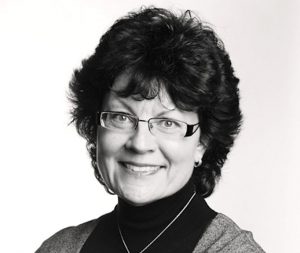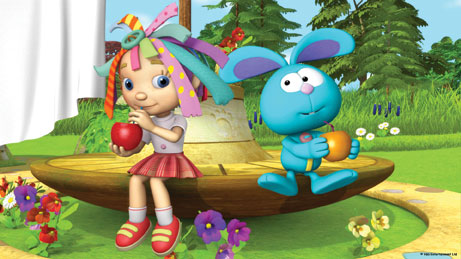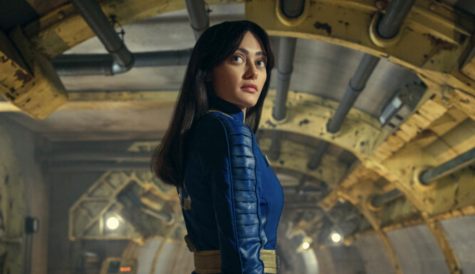Girls want toons!
Commissioners want more girl-skewed animation and say there is not enough coming their way. Producers say that commissioners often shun girl-skewed ideas as they are worried boys will turn off. Meanwhile, a handful of shows with girl characters are global hits.
Asking kids TV executives why there are not more cartoons with lead girl characters or girl-skewing shows, elicits a similar answer, that it is because girls will watch shows aimed at boys, but not vice-versa. Also, often cited is the idea that girls move away from cartoons and on to live-action and are tuning into Hannah Montana while their brothers are still glued to animated fare.
With tens of thousands of hours of animated content produced annually, there are inevitably some ‘girls’ shows including Dora the Explorer, Totally Spies, Peppa Pig, Olivia and Winx Club that are, or have been, bona-fide international hits. But there has historically been reluctance to greenlight shows skewed toward girls or with girl leads.
Kay Benbow has been controller of CBeebies since May 2010 and before that was head of production at the BBC’s digital kids channel. She has been the kids TV executive most vocal about the lack of girl-skewing toons, most recently telling delegates at the Children’s Media Conference in Sheffield, UK, that there was still a dearth of these shows.
“I have said for a while that a majority of proposals coming across my desk were boy-led ideas and I think you have to ask the right questions of the creative and production community, as we always would with a live-action show.” Kay Benbow, controller CBeebies
“I have said for a while that a majority of proposals coming across my desk were boy-led ideas and I think you have to ask the right questions of the creative and production community, as we always would with a live-action show,” she says. “It’s not about being politically correct; it’s about making sure the audience sees itself reflected back on screen.
“There have always been girl characters, but they were usually secondary, there was a perception that boys wouldn’t watch girl leads although girls would watch boys. Recent research has challenged that perception and as many boys as girls watch Everything’s Rosie, for example. It’s a young, fresh, girl-led show and next year we will have another, Sarah & Duck.”
The latter will be produced by UK indie Karrot Entertainment and air on CBeebies in the UK and the BBC Worldwide-operated international CBeebies channels. V&S Entertainment’s Everything’s Rosie, meanwhile, has just been picked up for a fourth season by CBeebies and with the addition of the new 26x11mins there will be 104 episodes of the show.
The idea boys won’t watch girls shows is a lazy assumption. Boys will watch Disney and Nickelodeon’s ostensibly girl-skewed live action shows for the funny, slapstick and spooky moments just as girls will watch the new Turtles or action series.
“It’s a myth that boys will not accept a girls show, maybe they won’t admit they have seen it, but if the ingredients are there they will watch for sure,” says Lionel Marty, president, worldwide distribution at Moonscoop. “I also think there’s an evolution of kids, especially in the Western world, where boys are more accepting of their feminine sides. There are examples such as Cartoon Network in France having telenovela series, which are working well despite it being a boy’s channel.”
Moonscoop distributes Chloe’s Closet. In each episode, the titular female lead goes into her closet and dresses up in a different costume. The fact it could be an astronaut’s outfit or that of a princess widens the gender appeal.
While the playing field has levelled, the dominance of boys toons in recent years created a window of opportunity for producers and broadcasters willing to take a risk on a girls show and determined enough to get it launched.
When Winx Club rolled out on Italy’s Rai, it was launching into a very boy-fuelled market for animation. The show, which is aimed at 4-to-7s and follows seven girl superheroes, the Winx Club. It has since become the first Italian animated property on US TV and has sold worldwide.
“In the late 90s when we were developing the show, the attention of producers and buyers was focused on boys and on action,” explains Iginio Straffi, the creator of Winx and founder of the company that produces it, Rainbow, which has its own studio in Ancona, Italy. “I was thinking they had forgotten about the girls and especially in terms of superheroes although Marvel had tried girl superheroes without success.
“It was very difficult to convince broadcasters and they thought that every boy would switch channels. I thought there was a gap in the market and Pokémon and Dragonball were scoring high with boys, but losing girls.”
Straffi says that the boy/girl split of viewers was even at first, but the larger Winx became the more it was defined as a show for girls. “Once the property was huge the idea was out that it was something for a specific target audience,” he says. “We have made ‘boys’ shows like Huntik, but we are perceived as the studio with a high level of know-how in making shows for girls, in the same way that Marvel makes shows for boys” he adds.
This perception has been reinforced with the animated shows that followed in Winx’s footsteps, Mia and Me and Pop Pixie. Rainbow is now looking at different styles and shows for different ages and has greenlit a concept for older girls that has been three years in development.
There is a distinction between different age groups and different types of broadcaster.
“You need to split it into preschool and tween and into multichannel and public broadcaster,” says Zoë Scurfield, head of development and production at Coolabi, the IP company that makes Poppy Cat.
Scurfield, who was at Disney for over a decade and was executive director of programming for Disney Channels in the UK, Scandi and emerging markets, says that as the multichannel universe has expanded, the broadcasters have been able to segment content for different genders and demos on different channels and commission accordingly. “The public broadcasters, meanwhile, need very strong entry points for boys and girls and need to appeal to both.” CBeebies’ Benbow agrees: “We do have a different responsibility,” she says.
The world of licensing and merchandising, which provides much of the income in the kids world, is rigidly pink or blue. If L+M is part of the plan from the earliest stage of a show’s development, the rights owners need to know the part of the toy store in which they want a presence.
Mike Dee, Coolabi’s director of content, says: “Preschool, boys and girls do not make different associations between boy and girls properties, but Mike Dee, Coolabi’s director of content, says: “Preschool boys and girls do not make different associations between boy or girl properties, but the adults do when they are buying products. The retailers are an important part of the chain and they split their aisles into boy and girl and there are few crossovers.”
With Poppy Cat, the retailer feedback ahead of the launch of consumer products was that the soft toy packaging had to be more pink because Poppy is a girl.
Hasbro Studios is well aware of off-screen commercial possibilities given that its shows are invariably based on intellectual property from the toy company itself. It owns Strawberry Shortcake and My Little Pony, which have both been made into TV series.
The latest show from the Hasbro Studios production arm is The Littlest Pet Shop. It is based on a range of collectible creatures. They did not have individual names in the toy world and to create a fully-fledged story Hasbro has introduced another brand, Blythe, based on a collectible doll it sold in the 1960s, as a key character. In the show she moves to the big city with her pilot dad and befriends and looks after the animals in the pet shop below her new home.
“It skews older than something like Dora or Strawberry Shortcake and is more sophisticated,” says Finn Arnesen, senior VP, international distribution and development at Hasbro Studios. “We’ve brought two brands together and have a fringe primetime entertaining comedy series. Empowering girls is important and the series shows girls that they can be anything they want to be. It is girl-skewed, but we hope boys will watch for the comedy.”
The after-school slot on many dedicated kids channels is ripe for a girl-skewed show like this ahead of a big-ticket boys action show, he adds.
How to appropriately reach a girl audience is another question. “There are a lot of projects out there all about fashion and looks, but that’s not necessarily what we need,” says Halle Stanford, executive VP, entertainment at The Jim Henson Company. It is developing Four Seasons, a CGI show about four sprites, of diverse ethnicities, who are the daughters of Mother Nature and embody each of the seasons.
“When we initially pitched it we were basically told ‘we’re not looking for properties aimed at girls’, which was frustrating for Lisa (Henson) and me. If that thinking is driven by the toy aisles of Toys R Us, people need to remember there is also a girl’s aisle.”
The preschool property will be developed as a publishing property while conversations carry on with potential TV partners.
The approach to portraying positive images of girls and women onscreen is a complex one, Halle adds. “The Geena Davis Institute studies gender in the media and how girls and women are represented in entertainment and that got us thinking about how girls should be portrayed and not just the as the main characters, but elsewhere such as in crowd scenes.”
The Geena Davis Institute’s research analysed a plethora of kids shows on US TV that aired in 2005 (and given the long-tail nature of kids TV, are likely still airing on a channel somewhere). It found that, broadly, male characters occur at twice the rate of their female counterparts and the imbalance is more marked in animated than live-action programming.
The study, An Analysis of Popular Films and TV, by Dr. Stacy L. Smith (Annenberg School for Communication) and Crystal Allene Cook (The Geena Davis Institute on Gender in Media) stated: “Clearly, animation appears to favour highly sexualised female characters with unrealistic body ideals.” It concluded: “Despite the Civil Rights Movement in the 1950/60s and the rise of second wave Feminism in the 1970s, on screen gender equality still does not exist.”
Screenwatch: SheZow!
Producers: Moody Street Kids, Kickstart Productions
Distributor: DHX Media
Concept: Comedy about a male/female superhero
Airing: Network Ten, ABC (Australia)
SheZow! is a 52x11mins animated series for 8-to-12s that truly straddles the gender divide. It follows a macho 12 year-old, Guy, who finds a ring that gives him superhero powers. However, the ring was meant to be worn by a girl, meaning that Guy is transformed into a superhero in a girls costume, replete with big hair, high heeled go-go boots and powers including female intuition.
The show is produced by Australia’s Moody Street Kids and LA-based Kickstart Productions for Australian free-to-air broadcaster Network Ten and public net ABC’s digital kids channel ABC3.
DHX is handling international sales of the comedy series and Josh Scherba, senior VP, distribution, says: “He is a superhero who finds his skirt is riding up as he is battling villains! We knew girls would get a kick from the story and also wanted to ensure there was a strong boy voice in there.
“Girls start watching live-action earlier than boys and to get that girl audience a show needs to be clever, something like Phineas and Ferb has broken through and has a strong, older girl audience.”
DHX had the first completed episodes of SheZow! at MIPJunior.
Case Study
Totally Spies: from anime to Franime
Totally Spies is arguably the original girl power series, in the Western world at least. The Marathon Media show mixes US-style humour with an anime visual style and is now the longest-running animation series ever produced in France. It has also broken into the US on Cartoon Network, which generally targets boys.
“Twelve years ago when we came up with the idea, people said, and still say, that if you are doing a show for girls it won’t attract a boy audience, which is a great mistake,” says David Michel, the show’s co-creator (with Vincent Chalvon-Demersay) and cofounder of Marathon, which is now part of Zodiak Media.
Chalvon-Demersay and Michel watched the ‘magical girl’ anime shows in Japan and series like Asahi and Toei’s long-running anime show Pretty Cure, which convinced them there was a gap in Western markets, particularly when these anime series started being exported and working in France and Southern Europe.
It was also the time of Girl Power and girl-skewed teen movies including Clueless and Bring it On, all of which fed into Totally Spies, which was made in a style dubbed ‘Franime’.
Michel says: “It went to TF1 and ABC Family (latterly Fox Kids, Jetix and now Disney XD) and although no-one was expecting it, it was a success. There are three girl leads it gets a 50-50 boy/girl audience wherever it runs, even in Lat-Am, Italy and Southern Europe where there is a more macho culture.”
Season six will debut on TF1. Disney France has pay TV rights and Nickelodeon has it for a large part of Europe. Cartoon Network in the US aired season one though five, but a US deal has not yet been concluded for the new series.










